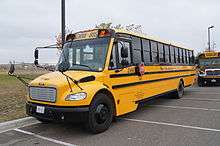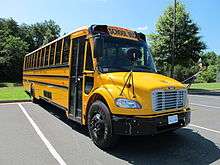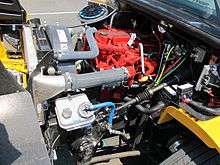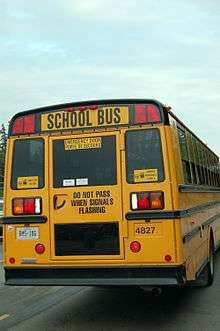Thomas Saf-T-Liner C2
| Thomas Saf-T-Liner C2 | |
|---|---|
 Front 3/4 view | |
 Interior view, looking back | |
| Overview | |
| Manufacturer | Thomas Built Buses |
| Production | 2004-present |
| Assembly | High Point, North Carolina |
| Body and chassis | |
| Chassis | Freightliner C2 |
| Related | Freightliner M2 Business Class |
| Powertrain | |
| Engine |
|
| Capacity | 14-81 |
| Dimensions | |
| Width | 96 in (2,438 mm) |
| Curb weight | 18,000–35,000 lb (8,165–15,876 kg) (GVWR) |
| Chronology | |
| Predecessor |
|
The Thomas Saf-T-Liner C2 (often shortened to C2) is a Type C (conventional-style) school bus produced by Thomas Built Buses. In production since 2004, the C2 is based on a Freightliner C2 chassis, itself derived from the Freightliner M2 Business Class medium-duty conventional. It was introduced as the replacement for the Thomas Conventional and Thomas Saf-T-Liner FS-65; the latter was produced alongside the C2 until December 2006.[1] Due to elements of its design, the C2 can also be considered the successor to the Vista line of Type C buses from the 1990s. The C2 is unique in that it is available in capacities up to 81 passengers, the largest of any type C conventional school bus in current production.[2]
The Saf-T-Liner C2 is built at a $40 million manufacturing facility in High Point, North Carolina.[3]
Background

Following the introduction of the Freightliner Business Class M2 medium-duty truck in 2002 as the replacement for the FL-Series, Freightliner began work on an all-new bus chassis based on the M2 to replace the FS-65 bus chassis. As the parent company of Thomas Built Buses, Freightliner sought to pair the new bus chassis together with a new Thomas body, allowing the bus company to update its Saf-T-Liner Conventional bus body for the first time since 1962.
In 2004, the Saf-T-Liner C2 entered production. The Saf-T-Liner FS-65 that it replaced remained in production until the end of 2006, outliving the Freightliner FL-Series it was derived from.
In October 2012, Thomas delivered its 50,000th Saf-T-Liner C2 to Dean Transportation of Lansing, Michigan.
Overview

Design and manufacture
As the first new Thomas full-size bus body since 1962, manufacturing techniques for the C2 were redesigned. To minimize the number of rivets and welds on the bus body, adhesive bonding was used for many body joints. In the cases where fasteners are needed, self-piercing rivets are used; ideally these do not punch completely through the bottom layer of the metals being joined together, thus reducing the likelihood that rivets will become the source of leaks in the future.
To simplify vehicle maintenance, Thomas introduced multiplexed wiring, replacing individually wired circuits. In the system used in the C2, it also has the advantage that switches on the control panel next to the driver can be rearranged to suit the driver and continue to function without any rewiring or reprogramming.
Chassis

Although the Freightliner M2 was also developed for use in cutaway applications at its launch in 2002, the use of the M2 chassis for school bus applications paired lead Freightliner subsidiary Thomas Built Buses and Freightliner to develop the Saf-T-Liner C2 as an entire vehicle. Unlike its FS-65 predecessor, the C2 chassis has been paired exclusively with Thomas-manufactured bodies; the Freightliner grille badges are replaced with Thomas badges.
At its launch, the Mercedes-Benz MBE904 and MBE906 diesel engines were the standard engines, with optional Caterpillar C7 and Cummins ISB diesels. In 2008, the Cummins ISB6.7 replaced the MBE900 and C7 diesels.
The C2 comes standard with an Allison 2500 automatic transmission with an Allison 3000 automatic transmission as an option. A rarely ordered option is a Fuller 6-speed manual transmission, the only school bus in North America offered with a manual transmission.
| Engine | Configuration | Fuel | Notes | Transmission |
|---|---|---|---|---|
| Caterpillar C7 | 7.2 L (441 cu in) turbo I6 | diesel | optional engine, discontinued after 2007 | Allison 2500 automatic
Allison 3000 automatic Fuller 6-speed manual |
| Cummins ISB6.7 | 6.7 L (409 cu in) turbo DOHC I6 | diesel
CNG |
available 2008-present; produced with diesel-electric powertrain from 2008-2013 | |
| Mercedes-Benz MBE900 | 4.2 L (259 cu in) turbo I4 (MBE904)
4.8 L (293 cu in) turbo I4 (MBE 924) 6.4 L (388 cu in) turbo I6 (MBE906) |
diesel | standard engine at launch, discontinued after 2007 | |
| Powertrain Integration PIthon | 8.0 L (487 cu in) OHV V8 | propane/LPG | available 2014-present |
Exterior

Along with the Freightliner M2-derived chassis, for the Saf-T-Liner C2, Thomas Built Buses uses a body design unique for the vehicle. Sharing no parts with any previous Thomas school bus, the C2 was designed with several key factors in mind, many of them to tie into the advanced design of its donor chassis.
To improve aerodynamics of the bus body, the windshield was sloped rearward rather than vertically; instead of multiple flat panes, a curved, bonded piece of glass was used, in order to resist chips by more effectively deflecting objects.[4] Where state regulations allow, the lenses for the red and yellow warning lights are faired into the body as well.
To maximize parts compatibility, the stock Freightliner M2 cowl is used; while the windshield is taller, the Thomas C2 uses the same windshield wipers seen on the M2.
In late 2007, a minor update to the Saf-T-Liner C2 was made. To improve driver sightlines, the mirror bracket for the passenger-side rear-view mirrors was extended. The passenger windows were redesigned, with equal-sized window sashes (previously, the top half was larger). In the rear, the taillights were redesigned and enlarged, later becoming a standard design for all Thomas buses.
Interior
In the development of the Saf-T-Liner C2, many advancements were made in the development of the interior of the school bus. In previous conventional-style school buses, from the firewall rearward, few parts from the chassis manufacturer were retained aside from the steering column and instrument cluster. For the design of the C2, Thomas and Freightliner designed the vehicle to retain the dashboard of the Freightliner M2 106 in its entirety. Only a few changes were made, with the ignition moved to the center of the dashboard, as a driver switch panel was located to the left of the driver (full-size school buses do not have a traditional driver-side entry door).
Along with its role in aerodynamics, the larger windshield played a role in safety by minimizing blind spots. Due to the slope of the windshield, Thomas moved the entry door further back, adding a large window ahead of the main entry door to improve visibility around the loading zone (similar to the Thomas Vista and nearly all small school buses). Along with a taller body, the passenger windows were enlarged compared to other Thomas buses. Additionally, the C2 has larger emergency exits compared to the FS-65 and the Thomas Saf-T-Liner Type D buses.[5]
Along with an air-operated entrance door, in 2012, Thomas added an electrically-operated entrance door as an option. Since 2016, an manually operated passenger entry door was added as an option.
Variants
Other uses
Alongside the yellow school bus version, Thomas Built Buses offers MFSAB versions (activity/childcare versions) of the Saf-T-Liner C2, along with the commercial-use Transit Liner C2, and specialty versions of the C2 converted by aftermarket manufacturers for various uses.[6]
Alternative fuel/hybrid powertrains
In 2007, Thomas introduced a hybrid-electric version of the Saf-T-Liner, named the C2e. Designed as a parallel hybrid, the C2e retains the Cummins ISB engine, adding a lithium-ion battery pack with an electric motor/generator. In the summer of 2013 Thomas removed the C2e product literature from their website; it is uncertain if the C2e remains an offered product.
In May 2014, Thomas Built Buses began production of a propane-fueled version of the Saf-T-Liner C2.[7] The bus is powered by a 339 hp 8.0L V8 designed by Powertrain Integration, an OEM supplier to General Motors. Named the PIthon,[8] the propane-fueled V8 is unrelated to the L18 8.1L V8 used in the 2009-2011 propane Blue Bird Vision. As with its diesel counterpart, the PIthon V8 engine is paired with an Allison 2300PTS automatic transmission.
In 2016, Thomas began production on a compressed natural gas (CNG) variant of the Saf-T-Liner C2. Using a CNG-fueled version of the Cummins ISB 6.7 engine, the vehicle is the first Type C (conventional-style) school bus to be produced with a CNG fuel system.[9]
Comparable products
External links
- Yellow Bus, Thomas Saf-T-Liner C2 - Thomas Built Buses - manufacturer website
| Wikimedia Commons has media related to Thomas Saf-T-Liner C2. |
See also
References
- ↑ http://www.thomasbus.com/bus-models/type-c/fs65-retired.asp
- ↑ http://www.thomasbus.com/bus-models/school/saf-t-liner-c2/standard-features.asp
- ↑ http://www.thomasbus.com/bus-models/school/saf-t-liner-c2/overview.asp
- ↑ http://www.thomasbus.com/bus-models/school/saf-t-liner-c2/standard-features.asp
- ↑ http://www.thomasbus.com/bus-models/school/saf-t-liner-c2/safety.asp
- ↑ "All Thomas Buses - Thomas Built Buses". www.thomasbus.com. Retrieved 2015-10-17.
- ↑ "New Propane-fueled Saf-T-Liner C2 in Production at Thomas Built Buses - Bus Report: May 2014 - Thomas Built Buses". www.thomasbus.com. Retrieved 2016-07-08.
- ↑ "8.0L PIthon engine to power Thomas Built propane bus - Alternative Fuels - School Bus Fleet". www.schoolbusfleet.com. Retrieved 2016-07-08.
- ↑ "Saf-T-Liner C2 (Type C) Compressed Natural Gas (CNG) - Green Bus - Thomas Built Buses". www.thomasbus.com. Retrieved 2016-06-30.